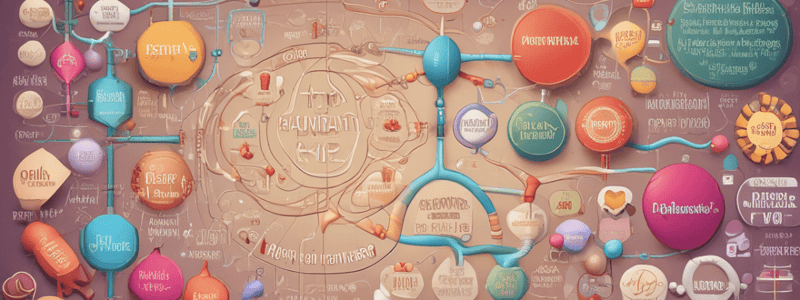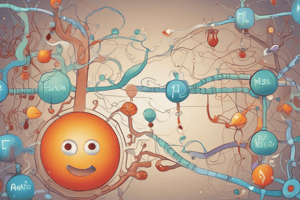Podcast
Questions and Answers
What is the primary function of the pentose phosphate pathway in the liver?
What is the primary function of the pentose phosphate pathway in the liver?
- Storage of glucose as glycogen
- Breakdown of glucose for energy
- Production of NADPH for anabolic processes (correct)
- Production of ATP
What is the primary consequence of hyperlactatemia above the renal threshold?
What is the primary consequence of hyperlactatemia above the renal threshold?
- Increased blood pH
- Decreased blood pH (correct)
- No change in blood pH
- Increased ATP production
What is the primary role of galactose in the body?
What is the primary role of galactose in the body?
- Storage of glucose as glycogen
- Synthesis of glycolipids and glycoproteins (correct)
- Energy production through glycolysis
- Regulation of blood sugar levels
What is the primary site of galactose metabolism in the body?
What is the primary site of galactose metabolism in the body?
What is the consequence of galactose accumulation in galactosemia?
What is the consequence of galactose accumulation in galactosemia?
What is the primary enzyme deficiency in classical galactosemia?
What is the primary enzyme deficiency in classical galactosemia?
What is the primary function of lactase in the digestive system?
What is the primary function of lactase in the digestive system?
What is the primary importance of detecting galactosemia in early life?
What is the primary importance of detecting galactosemia in early life?
What is the net ATP production per mole of glucose during glycolysis?
What is the net ATP production per mole of glucose during glycolysis?
What is the purpose of the lactate dehydrogenase reaction in anaerobic cells?
What is the purpose of the lactate dehydrogenase reaction in anaerobic cells?
What is the function of glycolysis in terms of ATP production?
What is the function of glycolysis in terms of ATP production?
What is the byproduct of the lactate dehydrogenase reaction in the absence of oxygen?
What is the byproduct of the lactate dehydrogenase reaction in the absence of oxygen?
What is the role of dihydroxyacetone phosphate in triglyceride synthesis?
What is the role of dihydroxyacetone phosphate in triglyceride synthesis?
What is the purpose of the connecting stage 2-3 in carbohydrate catabolism?
What is the purpose of the connecting stage 2-3 in carbohydrate catabolism?
What is the significance of 1,3-Bisphosphoglycerate in red blood cells?
What is the significance of 1,3-Bisphosphoglycerate in red blood cells?
What is the purpose of glycolysis in terms of NADH production?
What is the purpose of glycolysis in terms of NADH production?
What is the primary function of glycosidases in the GI tract during stage 1 of carbohydrate catabolism?
What is the primary function of glycosidases in the GI tract during stage 1 of carbohydrate catabolism?
Which of the following is NOT a characteristic of stage 1 of carbohydrate catabolism?
Which of the following is NOT a characteristic of stage 1 of carbohydrate catabolism?
What is the primary function of GLUT1-GLUT5 transporters in the small intestine?
What is the primary function of GLUT1-GLUT5 transporters in the small intestine?
Which tissue has an absolute requirement for glucose and cannot metabolize fatty acids?
Which tissue has an absolute requirement for glucose and cannot metabolize fatty acids?
What is the primary difference between the breakdown of starch and glycogen in the GI tract?
What is the primary difference between the breakdown of starch and glycogen in the GI tract?
What is the function of isomaltase in the small intestine?
What is the function of isomaltase in the small intestine?
Which of the following is a characteristic of glucose regulation in the body?
Which of the following is a characteristic of glucose regulation in the body?
What is the primary function of pancreatic amylase in the small intestine?
What is the primary function of pancreatic amylase in the small intestine?
Flashcards are hidden until you start studying
Study Notes
Carbohydrate Metabolism
- Hyperlactatemia: 2-5mM lactate, below renal threshold, no change in pH, kidneys can dispose of lactate
- Lactic acidosis: >5mM lactate, above renal threshold, blood pH lowered
Pentose Phosphate Pathway (Hexose Monophosphate Shunt)
- Not all glucose 6-phosphate enters glycolysis, some is metabolized via the pentose phosphate pathway (oxidative, no ATP produced)
- Important pathway for liver, red blood cells, and adipose tissue
- Functions:
- Produce NADPH (reducing power for anabolic processes such as lipid synthesis)
- Maintain free -SH (thiol) groups on cysteine residues in certain proteins (important in G6PDH deficiency)
- Produce C5-sugar ribose for nucleotide synthesis (DNA and RNA)
Galactose Metabolism
- Galactose is required for the synthesis of glycolipids and glycoproteins (e.g., blood group antigens A, B, and O)
- Dietary lactose is hydrolysed by lactase to release glucose and galactose, which are absorbed into the bloodstream
- Galactose is metabolized largely in the liver (some in the kidney and GI tract)
- Lactose = galactose + glucose
Galactosemia
- Genetic condition with 2 variants: classical galactosemia (deficiency of galactose 1-P uridyltransferase) and non-classical galactosemia (deficiency of galactokinase)
- Accumulation of galactose leads to accumulation of galactitol, which utilizes NADPH, depleting NADPH from tissues
- Patient safety: galactosemia should be detected in early life for effective management
Catabolism of Carbohydrates - Stage 2
- Intracellular (cytosol): glycolysis/pentose phosphate pathway
- Intracellular (mitochondria): connecting stage 2-3
- Phase 1 (reactions 1-3): energy investment (2 moles ATP per 1 mol glucose)
- Phase 2 (reactions 4-10): energy production (4 moles ATP per 1 mol glucose)
- Functions:
- Yields NADH (reducing power)
- ATP produced from ADP (net: 2 moles ATP per mol glucose)
- Produces C6 and C3 intermediates (links to other metabolic pathways)
- Features:
- Exergonic (reactions 7 and 10 generate ATP)
- C6 (glucose) generates 2 C3 (pyruvate)
- Lactate from pyruvate can be generated in the absence of oxygen
Lactate Dehydrogenase Reaction
- Occurs in cells with limiting oxygen availability (RBC, skeletal muscle, brain, skin, and GI)
- Lactate released into blood and metabolized in the liver and heart, and is disposed of by the kidneys
- Regenerates NAD+ needed for glycolysis when NADH is being used up
- Blood levels < 1mM
Clinical Relevance - Stage 2
- Glycolysis needs NAD+ to oxidize glucose
- As total NAD+ and NADH is constant, when all NAD+ is converted to NADH, glycolysis stops
- NAD+ needs to be regenerated by another route
- Glycolysis intermediates are important for other metabolic routes:
- Triglyceride and phospholipid synthesis
- Regulator of oxygen affinity to hemoglobin
Catabolism of Carbohydrates - Stage 1
- GI tract (extracellular): breakdown and absorption
- Breakdown: hydrolysis of glycosidic bonds to glucose, galactose, and fructose
- GI tract enzymes: glycosidases (amylases)
- Saliva: amylase (starch, glycogen -> dextrins)
- Pancreas: amylase (major enzyme)
- Small intestine: disaccharides attached to brush border membrane of epithelial cells
- No significant hydrolysis of cellulose, no enzymes to attack the beta 1-4 linkages
Clinical Relevance - Stage 1
- Glucose requirements of tissues:
- Major sugar in blood
- All tissues can metabolize glucose
- Blood glucose regulated (~5 mM) by hormonal regulation (insulin, glucagon)
- Some tissues (RBC, lens of eye) have an absolute requirement on glucose
- Uptake by these tissues depends on blood glucose
- CNS (brain) prefers glucose and cannot metabolize fatty acids
- Some tissues need it for specialized functions (liver, adipose)
Studying That Suits You
Use AI to generate personalized quizzes and flashcards to suit your learning preferences.




